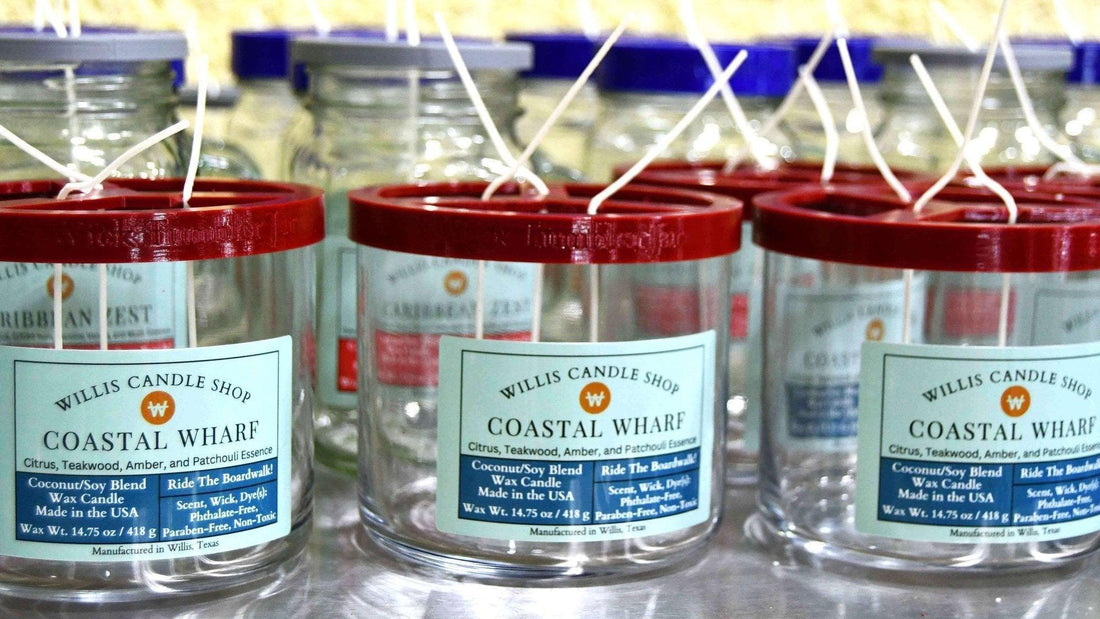
Crafting 14 Quality Scented Candles Video | Willis Candle Shop
Our Commitment to Clean, Natural Craftsmanship
Here at the Willis Candle Shop, we’re not just pouring wax and calling it a day—we’re crafting candles with care and intention, using clean-burning, phthalate-free, paraben-free, and non-toxic ingredients. Our process highlights natural wax characteristics, embracing the beauty of artisanal craftsmanship without shortcuts or unnecessary additives.
The Pouring and Curing Process
We start by pouring our coconut-soy wax blend into vessels, giving the candles a steady 24-hour rest at 72° to 73°F to help them settle smoothly. Then, they cure for 9 days at a fluctuating temperature between 65° and 75°F. This curing phase bonds the wax, fragrance oils, and color dyes (if added), setting the stage for a clean, even burn and a rich scent throw. It’s also when natural quirks, like frosting and cold spots, can appear.
Understanding Frosting in Natural Wax Candles
Frosting—a light, crystalline pattern on the surface—is common in colored candles and occurs when triglycerides in the wax naturally separate. While our white wax option hides it beneath the surface, colored candles may display unique frosted patterns that vary by batch. Occasionally, frosting even results from soy wax residue on the wick melting and settling during curing. And no, a heat gun won’t erase it—it’ll just shift it around.
Why Frosting is a Mark of Authenticity
So, when you see that light frosting, consider it proof of our all-natural production process and the handmade touch you didn’t know you needed.
What Are Cold Spots in Candle Making?
Cold spots, on the other hand, are small areas of uneven wax adhesion that occur in clear glass vessels as the wax pulls slightly away from the sides during curing or temperature changes. They can be temporarily “fixed” with a heat gun or freezer trick, but they’ll likely return when room conditions shift. To avoid seeing them altogether, consider choosing a frosted, tinted, or opaque vessel where the spots stay hidden. While this won’t eliminate frosting, it can create a cleaner appearance overall.
Why We Don’t Use Additives to Hide Flaws
Why don’t we “fix” these imperfections with unnecessary additives? Because we won’t compromise. These additives would smooth things out but at the expense of quality and authenticity. Instead, we embrace the unique personality of every candle while ensuring that all our ingredients are safe for you and the environment. While we do use high-quality synthetic fragrance oils and dyes, they’re carefully chosen to be non-toxic and free from harmful chemicals.
The Final Finishing Touches
On Day 11, we trim the wicks, smooth any surface imperfections with a heat gun, and give the candles one last cooling session before placing the lids on and storing them in our inventory. From there, they’re ready to bring warmth, fragrance, and charm into your home.
FAQs
How to Choose Between Minimalism and Character
So, if you want a clean, minimalist look, the white wax or a tinted vessel might be your best option. But if you’re someone who appreciates the beauty of artisanal quirks, embrace the frosting, cold spots, and natural variations that make every Willis Candle Shop creation one of a kind.
Why Our Materials Matter in Every Burn
At Willis Candle Shop, our handmade candles are crafted from a proprietary blend of coconut soy candles that balance clean-burning performance with luxurious scent throw. Whether you're looking for glass candles, jar candles, or wood wick candles, each batch is designed to reflect our eco-conscious values. We use non-toxic candles with phthalate-free candles oils that provide rich, layered aromas without harsh chemicals. That’s why customers shopping for natural candles, long burning candles, or even bulk candles for gifts and events trust us for quality that’s as honest as it is beautiful.
Why Our Process Stands Apart in the Candle Industry
Every part of our process—from wax selection to final storage—is rooted in craftsmanship, not automation. We’re not just another candle shop online; we’re a veteran-owned business dedicated to making luxury candles without shortcuts. We reject filler waxes and synthetic blends that produce inconsistent flames, soot, or poor scent diffusion. Instead, we rely on small-batch methods that ensure quality control and bring out the natural richness in fragrances like vanilla candle, patchouli candle, and coffee candle. It’s this dedication that sets us apart from mass-market competitors and makes each candle a piece of functional art.
Further Reading & Resources
See why we recommend coconut soy wax blended candles on our Ultimate Guide blog page. Check out additional details on candle production at our companion blog page.
See what Nancy Rubin has to say about choosing the perfect candle gift.













2 comments
Hey Veronica, I’m glad you got something out of the candle production narrative at the Willis Candle Shop. We try to help people understand why their candles may not look like the candles they see at Bath & Body Works or other retailers who specialize mostly in paraffin wax candles with additional additives. While those are good candles, they aren’t the healthiest option for a cleaner burn when considering air quality and potentially harmful additives that just aren’t necessary for candle performance and have a lot to do with candle appearance, only!
Thank you for all the explanatory information and sharing the timelines you use for your candle production. Understanding why the candles settle the way they do is great to know.